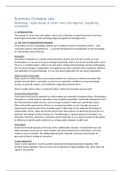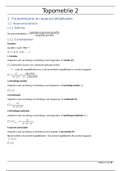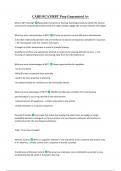Summary Company Law
Heldeweg – legal design of smart rules and regimes: regulating
innovation
3.1 INTRODUCTION
The concept of ‘smart rules and regimes’ aims to focus attention on legal instruments that foster
technological innovation while providing safeguards against technological risks.
3.2 THE ‘DUTCH (INNOVATION) PARADOX’
‘An excellent record in knowledge creation, but a mediocre record in innovation activity’ – with
‘innovation activity’ being defined as, ‘… successful development and application of new knowledge
in a new product and/or process’.
Innovation
Innovation is regarded as a concept embracing both a process and it results in terms of a new
functionality or a new way of using an existing functionality, both in the private and the public sector.
Thus it is a ‘complex system’, which is not only about creating new knowledge and new technologies,
but also about changes in organization, management and labor, towards faster recognition, diffusion
and application of (new) knowledge. It is not only about exploration but also about exploitation.
Failure at and in innovation
Major causes of market failure concerning innovation are: reluctance to initiate innovation with
positive external effects, uncertainty on returns on investment, insufficient or slow knowledge
transfer, small profit margins, and insufficient cooperation between firms.
Next to market failure, there is ‘systematic failure’ within the innovation process itself.
Government opportunities
Government may have the potential to rectify market and systematic innovation failure. Technological
innovation is a public interest, especially in view of global competition, sustainable development and
the improvement of public services, such as energy, transport, health care and infrastructures.
Taken intrinsically, government will focus on securing innovation as such, through securing or
improving the ‘general rules of the innovation game’ rather than on any particular technology or
related public service. Taken extrinsically, government interventions are geared by the promise of a
particular technology to either function as a ‘breakthrough’ or ‘general purpose technology’ (e.g.
electricity, chemistry, electronics, computers and the Internet), or as a means to improve the quality
or efficiency of specific public interests (e.g. energy, public transport, health care).
More failure
Government should operate on the basis of the ‘additionality-principle’. It should intervene only
when and where necessary (i.e. when markets and social networks fail at innovation), and must
retreat as soon as possible. The additionality-principle ‘responds’ primarily to the dangers of
government failure relating to innovation.
A smart approach?
Clearly ‘dumb regulation’ must be avoided; especially technology-dependent regulation. Still,
avoiding ‘dumb regulation’ does not cover the full spectrum of legal strategies that ‘smart rules and
regimes’ may provide.
,X may be understood as conduct favorable to technological innovation and Y depicts the agent(s)
addressed.
In the prohibitive (y shall not do x) perspective, the focus is on risk regulation. That is, the regulatory
safeguarding of public interests in a clean environment. This comes with a view on how risk
regulation can meanwhile accommodate technological innovation.
= innovative risk regulation. In fostering innovation, the choice and design of regulatory restrictions
should reflect innovation-efficiency and innovation effectiveness.
Innovation-efficiency is about avoiding over-inclusiveness of norms: prohibiting more than is
necessary to protect vulnerable interests.
Innovation-effectiveness is about promoting more desirable innovations by placing restrictions on
existing or emerging technologies. Such restrictions could operate as a push towards a technological
shift to a new or improved technological functionality.
In the permissive (y may or may not do x) perspective, our focus lies with creating favorable
regulatory conditions towards enhancing technological innovation as a matter of private choice.
= innovation-facilitating regulation. The baseline of facilitation is to ensure the presence of a legal
infrastructure favourable to technology innovation; based on public interest considerations but
geared to foster private interests, so that private actors may act upon expected private ‘gains’.
In a compelling (y shall do x) perspective, innovation is a public interest that warrants active
persuasion, through regulation that obliges innovative conduct.
= innovation-compelling regulation.
1. Through direct regulation, where conduct follows ‘command and control’ and breaches are
punishable under law, which features prohibitions and commands aimed at shifting from existing
undesirable technologies to new and promising technologies.
2. Through indirect regulation, where conduct follows efficiency considerations and is sanctioned by
economic disadvantage, such as by taxation.
3. Through self-regulation, where conduct follows social considerations and is sanctioned by criticism
and ostracism.
4. The use of inherent regulation, where conduct follows inbuilt or systematic constraints of
functionalities, sanctioned by absence or loss of (physical) functionality.
Balancing act
Not only must technological innovation be fostered, but there is also the public interest of securing
against technological risks. Ideally, both interests must be acted upon jointly, indifferent to whether
the initiative to act lies with fostering innovation or curbing risks.
3.3 THE CONCEPT OF ‘SMART RULES AND REGIMES’
Rules = linguistic statements, projecting a mode of conduct or a power conferred, which is prescribed
or attributed (bindingly) in instances as defined within the rule (or its underpinning rules).
- Y is the subject
- X is the conduct
,Regime = system of rules, which in conjunction includes not only norms, but also the mechanisms of
decision making and the network of involved actors.
Wicked problems, smart response
A combination of two circumstances – high dynamics and major conflict – presents a ‘wicked
(regulatory) problem’, such as is manifest in debates on technological innovation and the likelihood,
magnitude and distribution of their risks and benefits. Clearly, these problems pose a challenge to
regulatory governance, that is, to the design of smart rules and regimes, aimed at balancing both
dynamics and conflicts.
Variables and maxims
The smartness of rules and regimes related to balancing two variables: high dynamics and strong
conflicts of interests. This reflects underlying legal governance dimensions and accompanying
principles or maxims of regulatory effectiveness and efficiency and regulatory legitimacy and legal
validity.
Design of smart rules and regimes must rest upon guidelines, which do justice to these legal
governance dimensions and accompanying principles of good legal governance.
Four dimensions, four principles
Legitimacy is about ‘which particular regulatory interventions can legally be brought about by who?’
Its focus is on the id quod dimensions of the regulatory power to bind others.
Legitimacy should be understood primarily in legal terms, as the legal power or competence to bind
others legally or de facto, especially unilaterally.
In the context of technological innovation ‘legitimacy’ is the dimension determining which agents can
authoritatively decide on the introduction and use of new technologies.
Legal validity is about ‘how a particular regulatory intervention may/shall or can legally be brought
about?’ It focuses on the modus quo dimension of regulation in terms of the availability of regulatory
legal tools, respect for higher legal norms, and applicability of legal controls.
In the context of technological innovation this is the dimension where, in particular, the distribution
of risks and benefits of innovation will be tested.
Effectiveness is about ‘what particular regulatory intervention can practically be brought about?’ It
focuses on whether a rule or regime can result in intended (changes of) conduct.
Efficiency is about ‘how a particular regulatory intervention can practically be brought about?’ It is
concerned, firstly, with whether regulating is a ‘cost-effective’ policy effort to create presumably
effective rules or regimes. Secondly, it addresses the ‘cost-effectiveness’ of the rule or regime as
regards the impact on the regulated conduct.
The outcome efficiency depends on the relative behavior adjustment costs of the regulates.
From the standpoint of technology innovation ‘dynamic appropriateness’ needs to be ensured,
safeguarding targetedness through adaptability, focused on substantively safeguarding and, where
possible ‘freedom from regulation’ or a ‘permissive tilt’, again avoiding over-inclusiveness.
Regulatory ergonomics (or ergonomics of regulatory governance) not only call for a lowering of the
regulatory burden, but also the efficient allocation of obligations and (correlative) property rights (or
entitlements).
Name of the game
Interdependencies between legitimacy, legal validity, effectiveness and efficiency, place the ideal of
smartness of rules and regimes on a range between satisficing and optimising.” As satisficing requires
, meeting minimum criteria for each maxim, not allowing any trade -offs; optimising, although initially
geared towards best performance on each count, does also allow for balancing between dimensions
or maxims (with respect of minimum criteria).
3.4 THE CONCEPT OF A LEGAL DESIGN METHODOLOGY (TOWARDS ‘SMART RULES AND REGIMES’)
An institutional approach
Legal institutions depict a normative mode of human behaviour in the form of (1) a system of rules
(2) projecting a state of affairs (3) that ought to be realised (4) by a social practice regulated by those
rules and (5) expressive of a common belief that the state of affairs is (6) actually the case.
Legal design is, after all, primarily concerned with conceiving, as concepts, possible institutional
practices and their corresponding ‘systems of legal norms suited to elicit and control such practices’.
As such the design of concepts of legal artefacts provides the foundation for (guideline-based)
conceptualisations of individual instances of such artefacts, suited to a particular situation.
An internal perspective
A fitting methodology could firstly address rules projecting legal norms of conduct and, secondly,
rules projecting power conferring norms legal acts.
As to the design of legal norms of conduct (‘x shall/may (not) do y (when Z)’), Ruiter proposes that
their design should adhere to the following three guidelines:
1. take into consideration the four basic components of every norm: Subject (‘x’), Object (‘y’),
Operator (‘shall or may (not)’), and Conditions (‘z’);
2. decide to which extent the logical oppositions (in variations of ‘shall or may (not) do’: command,
prohibition, permission and dispensation) are relevant determinants of the design;
3. establish whether the design is such as to generate legal relations (according to Hohfeld) of a
‘claim-duty’ or ‘privilege-no-claim’ nature (discriminating between different kinds of rights – ‘claims’
and ‘privileges’ – and their legal opposites – ‘duties’ and ‘no-claims’), and, if so, whether the
respective rights holder positions and rights addressee positions are properly specified (in terms of
unital and multital relations – MAH).
Combining the positions of the components object and operator, yields four basic types of norms of
conduct (‘command’, ‘prohibition’, ‘permission’ and ‘dispensation’) together with their reciprocal
relations: contradictory, contrary, subaltern or subcontrary.
Next to norms of conduct we must consider power-conferring norms, or norms of competence, which
enable one or more agents to create or abolish legal norms. Such a ‘norm of competence’ requires
that we introduce, in addition to the norm-operators ‘shall’ and ‘may’, a third norm-operator: ‘can’,
signifying the ability to bring about legal effects especially through the performance of a legal act
(e.g. legislation, contracting).
Reflection on (1) norm-components, (2) logical oppositions, and (3) types of legal relations is vital to
the making of (regimes of) legal rules, and the specific nature of norms of competence should be well
understood.
3.6 CONCLUSIONS AND THE WAY FORWARD
Internal and external
At this stage of analysis, we must acknowledge that the focus on the internal structure of legal
institutions must be matched by a broader design scope, encompassing both rules and regimes.
The focus on the internal structure needs to be matched by an external view on the legal
consequences of regulatory governance or policy considerations.
Heldeweg – legal design of smart rules and regimes: regulating
innovation
3.1 INTRODUCTION
The concept of ‘smart rules and regimes’ aims to focus attention on legal instruments that foster
technological innovation while providing safeguards against technological risks.
3.2 THE ‘DUTCH (INNOVATION) PARADOX’
‘An excellent record in knowledge creation, but a mediocre record in innovation activity’ – with
‘innovation activity’ being defined as, ‘… successful development and application of new knowledge
in a new product and/or process’.
Innovation
Innovation is regarded as a concept embracing both a process and it results in terms of a new
functionality or a new way of using an existing functionality, both in the private and the public sector.
Thus it is a ‘complex system’, which is not only about creating new knowledge and new technologies,
but also about changes in organization, management and labor, towards faster recognition, diffusion
and application of (new) knowledge. It is not only about exploration but also about exploitation.
Failure at and in innovation
Major causes of market failure concerning innovation are: reluctance to initiate innovation with
positive external effects, uncertainty on returns on investment, insufficient or slow knowledge
transfer, small profit margins, and insufficient cooperation between firms.
Next to market failure, there is ‘systematic failure’ within the innovation process itself.
Government opportunities
Government may have the potential to rectify market and systematic innovation failure. Technological
innovation is a public interest, especially in view of global competition, sustainable development and
the improvement of public services, such as energy, transport, health care and infrastructures.
Taken intrinsically, government will focus on securing innovation as such, through securing or
improving the ‘general rules of the innovation game’ rather than on any particular technology or
related public service. Taken extrinsically, government interventions are geared by the promise of a
particular technology to either function as a ‘breakthrough’ or ‘general purpose technology’ (e.g.
electricity, chemistry, electronics, computers and the Internet), or as a means to improve the quality
or efficiency of specific public interests (e.g. energy, public transport, health care).
More failure
Government should operate on the basis of the ‘additionality-principle’. It should intervene only
when and where necessary (i.e. when markets and social networks fail at innovation), and must
retreat as soon as possible. The additionality-principle ‘responds’ primarily to the dangers of
government failure relating to innovation.
A smart approach?
Clearly ‘dumb regulation’ must be avoided; especially technology-dependent regulation. Still,
avoiding ‘dumb regulation’ does not cover the full spectrum of legal strategies that ‘smart rules and
regimes’ may provide.
,X may be understood as conduct favorable to technological innovation and Y depicts the agent(s)
addressed.
In the prohibitive (y shall not do x) perspective, the focus is on risk regulation. That is, the regulatory
safeguarding of public interests in a clean environment. This comes with a view on how risk
regulation can meanwhile accommodate technological innovation.
= innovative risk regulation. In fostering innovation, the choice and design of regulatory restrictions
should reflect innovation-efficiency and innovation effectiveness.
Innovation-efficiency is about avoiding over-inclusiveness of norms: prohibiting more than is
necessary to protect vulnerable interests.
Innovation-effectiveness is about promoting more desirable innovations by placing restrictions on
existing or emerging technologies. Such restrictions could operate as a push towards a technological
shift to a new or improved technological functionality.
In the permissive (y may or may not do x) perspective, our focus lies with creating favorable
regulatory conditions towards enhancing technological innovation as a matter of private choice.
= innovation-facilitating regulation. The baseline of facilitation is to ensure the presence of a legal
infrastructure favourable to technology innovation; based on public interest considerations but
geared to foster private interests, so that private actors may act upon expected private ‘gains’.
In a compelling (y shall do x) perspective, innovation is a public interest that warrants active
persuasion, through regulation that obliges innovative conduct.
= innovation-compelling regulation.
1. Through direct regulation, where conduct follows ‘command and control’ and breaches are
punishable under law, which features prohibitions and commands aimed at shifting from existing
undesirable technologies to new and promising technologies.
2. Through indirect regulation, where conduct follows efficiency considerations and is sanctioned by
economic disadvantage, such as by taxation.
3. Through self-regulation, where conduct follows social considerations and is sanctioned by criticism
and ostracism.
4. The use of inherent regulation, where conduct follows inbuilt or systematic constraints of
functionalities, sanctioned by absence or loss of (physical) functionality.
Balancing act
Not only must technological innovation be fostered, but there is also the public interest of securing
against technological risks. Ideally, both interests must be acted upon jointly, indifferent to whether
the initiative to act lies with fostering innovation or curbing risks.
3.3 THE CONCEPT OF ‘SMART RULES AND REGIMES’
Rules = linguistic statements, projecting a mode of conduct or a power conferred, which is prescribed
or attributed (bindingly) in instances as defined within the rule (or its underpinning rules).
- Y is the subject
- X is the conduct
,Regime = system of rules, which in conjunction includes not only norms, but also the mechanisms of
decision making and the network of involved actors.
Wicked problems, smart response
A combination of two circumstances – high dynamics and major conflict – presents a ‘wicked
(regulatory) problem’, such as is manifest in debates on technological innovation and the likelihood,
magnitude and distribution of their risks and benefits. Clearly, these problems pose a challenge to
regulatory governance, that is, to the design of smart rules and regimes, aimed at balancing both
dynamics and conflicts.
Variables and maxims
The smartness of rules and regimes related to balancing two variables: high dynamics and strong
conflicts of interests. This reflects underlying legal governance dimensions and accompanying
principles or maxims of regulatory effectiveness and efficiency and regulatory legitimacy and legal
validity.
Design of smart rules and regimes must rest upon guidelines, which do justice to these legal
governance dimensions and accompanying principles of good legal governance.
Four dimensions, four principles
Legitimacy is about ‘which particular regulatory interventions can legally be brought about by who?’
Its focus is on the id quod dimensions of the regulatory power to bind others.
Legitimacy should be understood primarily in legal terms, as the legal power or competence to bind
others legally or de facto, especially unilaterally.
In the context of technological innovation ‘legitimacy’ is the dimension determining which agents can
authoritatively decide on the introduction and use of new technologies.
Legal validity is about ‘how a particular regulatory intervention may/shall or can legally be brought
about?’ It focuses on the modus quo dimension of regulation in terms of the availability of regulatory
legal tools, respect for higher legal norms, and applicability of legal controls.
In the context of technological innovation this is the dimension where, in particular, the distribution
of risks and benefits of innovation will be tested.
Effectiveness is about ‘what particular regulatory intervention can practically be brought about?’ It
focuses on whether a rule or regime can result in intended (changes of) conduct.
Efficiency is about ‘how a particular regulatory intervention can practically be brought about?’ It is
concerned, firstly, with whether regulating is a ‘cost-effective’ policy effort to create presumably
effective rules or regimes. Secondly, it addresses the ‘cost-effectiveness’ of the rule or regime as
regards the impact on the regulated conduct.
The outcome efficiency depends on the relative behavior adjustment costs of the regulates.
From the standpoint of technology innovation ‘dynamic appropriateness’ needs to be ensured,
safeguarding targetedness through adaptability, focused on substantively safeguarding and, where
possible ‘freedom from regulation’ or a ‘permissive tilt’, again avoiding over-inclusiveness.
Regulatory ergonomics (or ergonomics of regulatory governance) not only call for a lowering of the
regulatory burden, but also the efficient allocation of obligations and (correlative) property rights (or
entitlements).
Name of the game
Interdependencies between legitimacy, legal validity, effectiveness and efficiency, place the ideal of
smartness of rules and regimes on a range between satisficing and optimising.” As satisficing requires
, meeting minimum criteria for each maxim, not allowing any trade -offs; optimising, although initially
geared towards best performance on each count, does also allow for balancing between dimensions
or maxims (with respect of minimum criteria).
3.4 THE CONCEPT OF A LEGAL DESIGN METHODOLOGY (TOWARDS ‘SMART RULES AND REGIMES’)
An institutional approach
Legal institutions depict a normative mode of human behaviour in the form of (1) a system of rules
(2) projecting a state of affairs (3) that ought to be realised (4) by a social practice regulated by those
rules and (5) expressive of a common belief that the state of affairs is (6) actually the case.
Legal design is, after all, primarily concerned with conceiving, as concepts, possible institutional
practices and their corresponding ‘systems of legal norms suited to elicit and control such practices’.
As such the design of concepts of legal artefacts provides the foundation for (guideline-based)
conceptualisations of individual instances of such artefacts, suited to a particular situation.
An internal perspective
A fitting methodology could firstly address rules projecting legal norms of conduct and, secondly,
rules projecting power conferring norms legal acts.
As to the design of legal norms of conduct (‘x shall/may (not) do y (when Z)’), Ruiter proposes that
their design should adhere to the following three guidelines:
1. take into consideration the four basic components of every norm: Subject (‘x’), Object (‘y’),
Operator (‘shall or may (not)’), and Conditions (‘z’);
2. decide to which extent the logical oppositions (in variations of ‘shall or may (not) do’: command,
prohibition, permission and dispensation) are relevant determinants of the design;
3. establish whether the design is such as to generate legal relations (according to Hohfeld) of a
‘claim-duty’ or ‘privilege-no-claim’ nature (discriminating between different kinds of rights – ‘claims’
and ‘privileges’ – and their legal opposites – ‘duties’ and ‘no-claims’), and, if so, whether the
respective rights holder positions and rights addressee positions are properly specified (in terms of
unital and multital relations – MAH).
Combining the positions of the components object and operator, yields four basic types of norms of
conduct (‘command’, ‘prohibition’, ‘permission’ and ‘dispensation’) together with their reciprocal
relations: contradictory, contrary, subaltern or subcontrary.
Next to norms of conduct we must consider power-conferring norms, or norms of competence, which
enable one or more agents to create or abolish legal norms. Such a ‘norm of competence’ requires
that we introduce, in addition to the norm-operators ‘shall’ and ‘may’, a third norm-operator: ‘can’,
signifying the ability to bring about legal effects especially through the performance of a legal act
(e.g. legislation, contracting).
Reflection on (1) norm-components, (2) logical oppositions, and (3) types of legal relations is vital to
the making of (regimes of) legal rules, and the specific nature of norms of competence should be well
understood.
3.6 CONCLUSIONS AND THE WAY FORWARD
Internal and external
At this stage of analysis, we must acknowledge that the focus on the internal structure of legal
institutions must be matched by a broader design scope, encompassing both rules and regimes.
The focus on the internal structure needs to be matched by an external view on the legal
consequences of regulatory governance or policy considerations.





